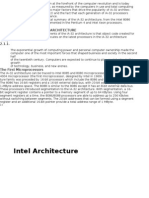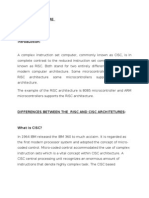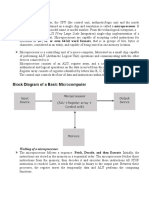What Is Processor ?
What Is Processor ?
Uploaded by
Arya SinghCopyright:
Available Formats
What Is Processor ?
What Is Processor ?
Uploaded by
Arya SinghOriginal Description:
Original Title
Copyright
Available Formats
Share this document
Did you find this document useful?
Is this content inappropriate?
Copyright:
Available Formats
What Is Processor ?
What Is Processor ?
Uploaded by
Arya SinghCopyright:
Available Formats
ARYA SINGH COMPUTER ARCHITEUTURE ASSESSMENT REG.NO.
:- 1847215
******************************************************************************
CIA 1 - B
What is Processor ?
The processor (short form for microprocessor and also often called the CPU or central
processing unit) is the central component of the PC. It is the brain that runs the show inside the
PC. All work that you do on your computer is performed directly or indirectly by the processor.
Obviously, it is one of the most important components of the PC.
Functions of Processor :
Performance
Software support
Reliability and Stability
Energy Consumption and Cooling
Motherboard Support
PROCESSOR FAMILIES OF INTEL
The processors here are grouped by "families", where we consider a family of
processors to be a group of processors that vary only in clock speed, not in architecture.
I will discuss here about all the major processor families used on PC-compatible
computers. It covers every major x86 processor on the market, from the first Intel 8088
used in the original IBM PC, to the latest released hot chips.
1. INTEL 8088- FIRST GENERATION PROCESSOR
The first chip used in PCs was Intel's 8088. This was not, at the time it was chosen, the best
available CPU, in fact Intel's own 8086 was more powerful and had been released earlier. The
8088 was chosen for reasons of economics: its 8-bit data bus required less costly motherboards
than the 16-bit 8086. Also, at the time that the original PC was designed, most of the interface
chips available were intended for use in 8-bit designs.
2. INTEL 80286- A SECOND GENERATION PROCESSOR
The 80286 was the chip used in IBM's AT (advanced technology) system. The 286 was the first
major step up in PC processors, providing significant performance increases over the 8088 and
8086--double or more performance at the same clock speed. The 286 also widened the address
bus to allow access to 16 MB of memory, and introduced protected mode operation. It was
originally available in 6 MHz and 8 MHz versions, but was later expanded to faster versions, all
the way up to 20 MHz.
3. INTEL 80386DX- THIRD GENERATION PROCESSOR
The Intel 80386DX was the first true 32-bit processor used on the PC platform. Its
internal register size was increased to 32 bits, and its data and address buses were as
well, doubling data path width to the processor and increasing addressable memory to 4
GB theoretical. The 80386 family of chips offered more performance than the 80286s
they replaced, largely through processor speed increases.
The 386DX's increased power and improved processor modes.
4. INTEL 80386SX- THIRD GENERATION PROCESSOR
The 80386SX is a "lite" version of the 80386DX chip. It uses only a 16-bit data
bus, the same external bus width as the 80286. It also only can address 16 MB of
memory, like the 80286. The SX version of the 386 chip was in fact released after the DX.
The narrower data bus width of the 386SX creates a reduction in performance of
about 20-25% compared to an equivalent-speed 386DX.
The 386SX is still a 32-bit processor internally and will run 32-bit software . It
available in speeds from 16 to 33 MHz
5. CYRIX 5x86 (“M1sc”)- FOURTH GENERATION PROCESSOR
Despite having the same name as AMD's 5x86 processor, the Cyrix 5x86 is a totally
different . While AMD designed its 5x86 by further increasing the clock on the 486DX4,
Cyrix took the opposite approach by modifying its M1 processor core (used for the 6x86
processor) to make a "lite" version to work on 486 motherboards. As such, the Cyrix 5x86 in
some ways resembles a Pentium OverDrive (which is a Pentium core modified to work in a
486 motherboard) internally more than it resembles the AMD 5x86. This chip is probably
the hardest to classify as either fourth or fifth generation.
6. AMD K5-FIFTH GENERATION PROCESSOR
AMD's entry in the fifth generation processor sweepstakes is called the K5
The K5 is, internally, a very advanced processor, the most advanced of the fifth-
generation chips. Internally it is more comparable to the Pentium Pro. It is an x86
translation/emulation processor, decoding x86 instructions into RISC-like microinstructions
and executing them on a 6-pipeline internal core. This allows the K5 to achieve higher
performance than a Pentium of the same speed. In many ways, the K5 is sixth-generation,
but its performance level is held back to fifth-generation levels due its low clock speeds.
7. INTEL PENTIUM PRO(“P6”)- SIXTH GENERATION PROCESSOR
The Pentium Pro was introduced in 1995 as the successor to the Pentium
The Pentium Pro was the first mainstream CPU to radically change how it
executes instructions, by translating them into RISC-like microinstructions and executing
these on a highly advanced internal core.
The Pentium Pro achieves performance approximately 50% higher than a
Pentium of the same clock speed
8. INTEL CORE 2- MULTI CORE PROCESSORS
The Core 2 brand refers to a range of Intel's consumer 64-bit dual-core and 2x2 MCM
quad-core CPUs with the x86-64 instruction set, based on the Intel Core micro architecture,
derived from the 32-bit dual-core Yonah laptop processor.
The Core 2 brand was introduced on July 27, 2006[3]comprising the Solo (single-core),
Duo (dual-core), Quad (quad-core), and Extreme (dual- or quad-core CPUs for enthusiasts)
branches, during 2007.[4] Intel Core 2 processors with vPro technology (designed for
businesses) include the dual-core and quad-core branches.
PowerPC
What is PowerPc ?
PowerPC is a microprocessor architecture that was developed jointly by Apple, IBM, and
Motorola. The PowerPC employs reduced instruction-set computing. The three developing
companies have made the PowerPC architecture an open standard, inviting other companies to
build on it.
The PowerPC architecture provides an alternative to the popular processor architectures from
Intel, including the Pentium. (Microsoft builds its Windows operating system offerings to run on
Intel processors, and this widely-sold combination is sometimes called "Wintel".) The PowerPC
was first used in IBM's RS/6000 workstation with its UNIX-based operating system, AIX, and in
Apple Computer's Macintosh personal computers. Today, PowerPC chips are also used in diverse
applications including internetworking equipment, routers, telecom switches, interactive
multimedia, automotive control, and industrial robotics.
The PowerPC offers the following features that POWER does not:
Support for running in little-endian mode.
Addition of single precision floating-point operations.
Control of branch prediction direction.
A hardware coherency model (not in Book I).
Some other floating-point instructions (some optional).
The real time clock (upper and lower) was replaced with the
time base registers (upper and lower), which don't countin
sec/ns (the decrementer also changed).
64-bit instruction operands, registers, etc. (in 64 bit processors).
Processors Families of PowerPc:
PowerPC 600 family
601 50 and 66 MHz
602 consumer products (multiplexed data/address bus)
603/603e/603ev notebooks, embedded devices
604/604e/604ev workstations and low end servers
620 the first 64-bit implementation
PowerPC 7xx family
740/750 (1997) 233–366 MHz
Motorola/Freescale
PowerPC 7xx family
PowerPC 740 and 750, 233-366 MHz.
745/755, 300–466 MHz
PowerPC 74xx family
7400/7410 350 - 550 MHz, uses AltiVec, a SIMD extension of the original
PPC specs.
7440/7450 micro-architecture family up to 1.5 GHz and 256 kB on-chip L2
cache and improved Altivec.
7447/7457 micro-architecture family up to 1.83 GHz with 512 kB on-chip
L2 cache.
7448 micro-architecture family (2.0 GHz) in 90 nm with 1MB L2 cache and
slightly improved AltiVec (out of order instructions).
8640/8641/8640D/8641D with one or two e600 cores, 1MB L2 cache.
Advanced RISE Machine
What is ARM Processor ?
An ARM processor is one of a family of CPUs based on the RISC (reduced instruction set
computer) architecture developed by Advanced RISC Machines (ARM). ARM makes 32-bit
and 64-bit RISC multi-core processors. RISC processors are designed to perform a smaller
number of types of computer instructions so that they can operate at a higher speed,
performing more millions of instructions per second (MIPS). By stripping out unneeded
instructions and optimizing pathways, RISC processors provide outstanding performance at a
fraction of the power demand of CISC (complex instruction set computing) devices.
ARM processors are extensively used in consumer electronic devices such
as smartphones, tablets, multimedia players and other mobile devices, such as wearables.
Because of their reduced instruction set, they require fewer transistors, which enables a smaller
die size for the integrated circuitry (IC). The ARM processor’s smaller size, reduced complexity
and lower power consumption makes them suitable for increasingly miniaturized devices.
ARM processor features include:
Load/store architecture.
An orthogonal instruction set.
Mostly single-cycle execution.
Enhanced power-saving design.
64 and 32-bit execution states for scalable high performance.
Hardware virtualization support.
The simplified design of ARM processors enables more efficient multi-core processing and
easier coding for developers. While they don't have the same raw compute throughput as
the products of x86 market leader Intel, ARM processors sometimes exceed the
performance of Intel processors for applications that exist on both architectures.
The head-to-head competition between the vendors is increasing as ARM is finding its way
into full size notebooks. Microsoft, for example, offers ARM-based versions of Surface
computers. The cleaner code base of Windows RT versus x86 versions may be also partially
responsible -- Windows RT is more streamlined because it doesn’t have to support a number
of legacy hardwares.
Processors Families of ARM:
1. The ARM Processor Families:
The ARM7 Family
32-bit RISC Processor.
Support three-stage pipeline.
Uses Von Neumann Architecture.
2. The ARM Processor Families:
The ARM9 Family
32-bit RISC Processor with ARM and Thumb instruction sets.
Supports five-stage pipeline.
Uses Harvard architecture Fetch Deco.
3. The ARM Processor Families:
The ARM10 Family
32-bit RISC processor with ARM, Thumb and DSP instruction sets.
Supports six-stage Pipelines.
Uses Harvard Architecture.
ARM1020E Processor
4. The ARM Processor Families:
The ARM11 Family
32-bit RISC processor with ARM, Thumb and DSP instruction sets.
Uses Harvard Architecture.
Supports eight-stage Pipelines except ARM1156T2 uses ninestage pipeline.
Widely used in automotive and industrial control systems, 3D graphics, security
critical
applications.
You might also like
- Xbox Architecture: Architecture of Consoles: A Practical Analysis, #13From EverandXbox Architecture: Architecture of Consoles: A Practical Analysis, #13No ratings yet
- PlayStation Architecture: Architecture of Consoles: A Practical Analysis, #6From EverandPlayStation Architecture: Architecture of Consoles: A Practical Analysis, #6No ratings yet
- The Architecture of Pentium MicroprocessorDocument26 pagesThe Architecture of Pentium MicroprocessorOwel LaguitanNo ratings yet
- Processor Families: by Prabhanshu Tripathi Ankit GuptaDocument25 pagesProcessor Families: by Prabhanshu Tripathi Ankit GuptaAnupam Kumar Sinha100% (1)
- Processor Families: by Prabhanshu Tripathi Ankit GuptaDocument25 pagesProcessor Families: by Prabhanshu Tripathi Ankit GuptaAnasNo ratings yet
- Intro To MicroDocument9 pagesIntro To MicroAnonymous Jy6ASdQ45JNo ratings yet
- Microprocessor Intel x86 Evolution and Main FeaturesDocument3 pagesMicroprocessor Intel x86 Evolution and Main Featuresezekiel nyamuNo ratings yet
- X86 ArchitetureDocument17 pagesX86 Architetureseety2No ratings yet
- Practical No. - 1Document55 pagesPractical No. - 1Rashi SharmaNo ratings yet
- CT4005NT WK02 L Introduction To Personal Computer Part 2-1Document27 pagesCT4005NT WK02 L Introduction To Personal Computer Part 2-1Niroj BhandariNo ratings yet
- CH&N UNIT-2(UPDATED)Document113 pagesCH&N UNIT-2(UPDATED)saleem.mujahid.538No ratings yet
- Microprocessor Architecture Tutorials: X64 vs. X86Document11 pagesMicroprocessor Architecture Tutorials: X64 vs. X86Maduranga AthukoralaNo ratings yet
- A Brief History of The Pentium Processor FamilyDocument43 pagesA Brief History of The Pentium Processor Familyar_garg2005100% (2)
- Cona Micro 2Document13 pagesCona Micro 2Jonathan CeballosNo ratings yet
- MicroprocessorsDocument4 pagesMicroprocessorsSudhakar SharmaNo ratings yet
- Preventing and Protecting Lifes of ComputersDocument24 pagesPreventing and Protecting Lifes of Computersdaniel0292016No ratings yet
- AMD Project DevelopmentDocument21 pagesAMD Project DevelopmentKurarin Jan MaikeruNo ratings yet
- Microprocessor Architecture: Protected ModeDocument4 pagesMicroprocessor Architecture: Protected ModeZohaib HassanNo ratings yet
- CHN Module 2Document35 pagesCHN Module 2Anandhu cNo ratings yet
- Reviewer in ArchiDocument8 pagesReviewer in ArchiJeaniebhel OducaNo ratings yet
- Experiment-1: Aim of The ExperimentDocument27 pagesExperiment-1: Aim of The ExperimentsoniaNo ratings yet
- 4thsem Microprocessor Notes PDFDocument148 pages4thsem Microprocessor Notes PDFVishal SharmaNo ratings yet
- Processor I7 (Seminar Report)Document14 pagesProcessor I7 (Seminar Report)feb29_21255906764% (14)
- Case StudyDocument73 pagesCase StudyMisha WaseemNo ratings yet
- The 8086 Microprocessor: 1.1 Introduction To Microprocessors and InterfacingDocument31 pagesThe 8086 Microprocessor: 1.1 Introduction To Microprocessors and Interfacingbabil_88No ratings yet
- Intel 8086 Microprocessor ArchitectureDocument12 pagesIntel 8086 Microprocessor ArchitectureYokito Yamada100% (1)
- Sharjeel Zaidi MicroprocessorDocument23 pagesSharjeel Zaidi MicroprocessorSharjil ZaiDiNo ratings yet
- Embedded Microcontrollers: Abebaw.ZDocument76 pagesEmbedded Microcontrollers: Abebaw.ZTamiru DerejeNo ratings yet
- Generations of Computer MicroprocessorsDocument68 pagesGenerations of Computer MicroprocessorsMKNo ratings yet
- Intel Architecture: 2.1. Brief History of The Ia-32 ArchitectureDocument19 pagesIntel Architecture: 2.1. Brief History of The Ia-32 ArchitectureBalu RajanNo ratings yet
- Reduced Instruction Set Computer: Main ArticleDocument3 pagesReduced Instruction Set Computer: Main ArticleLeandro MussoNo ratings yet
- Assignment 1 MicroprocessorsDocument8 pagesAssignment 1 MicroprocessorsUzair AslamNo ratings yet
- Chapter 2 MicrontrollersDocument61 pagesChapter 2 MicrontrollersAbdeta TerfaNo ratings yet
- Basic Comparison of PowerPC and Pentium Processor FamiliesDocument14 pagesBasic Comparison of PowerPC and Pentium Processor FamilieslokendrakashyapNo ratings yet
- Microprocessor Assignment: Priyank Mandal 285/C0/07Document11 pagesMicroprocessor Assignment: Priyank Mandal 285/C0/07Priyank MandalNo ratings yet
- Comparison of Intel Microprocessor 8086, 386, 486, Pentium IIDocument12 pagesComparison of Intel Microprocessor 8086, 386, 486, Pentium IIPulkit GoelNo ratings yet
- TO Micro Computer AND MicroprocessorDocument75 pagesTO Micro Computer AND MicroprocessorPiyush PandeyNo ratings yet
- x86 MicroarchitecturesDocument17 pagesx86 MicroarchitecturesGhe PataniNo ratings yet
- Mpi Chapter1Document57 pagesMpi Chapter1zinabuhaile26No ratings yet
- MicroprocessorDocument108 pagesMicroprocessorShailendra KumarNo ratings yet
- ScribedDocument6 pagesScribedHemant MehtaNo ratings yet
- Arm ArchitectureDocument63 pagesArm ArchitecturesrikanthpunNo ratings yet
- Introduction To Amd ProcessorsDocument10 pagesIntroduction To Amd ProcessorssagarkapoorNo ratings yet
- Evolution of MPDocument3 pagesEvolution of MPcoolvadivelNo ratings yet
- Microprocesso (Final)Document9 pagesMicroprocesso (Final)Jhunnel MaganesNo ratings yet
- Lecture1 Microprocessor Types and Specifications PDFDocument33 pagesLecture1 Microprocessor Types and Specifications PDFMuhammadKamranKhan50% (2)
- Computer Architecture and Organization: Intel 80386 ProcessorDocument15 pagesComputer Architecture and Organization: Intel 80386 ProcessorAtishay GoyalNo ratings yet
- Assembly Sheet 1Document14 pagesAssembly Sheet 1bananabeast0No ratings yet
- Perform Computer OperationsDocument29 pagesPerform Computer Operationsreynald manzanoNo ratings yet
- Unit-III Telugu AckDocument46 pagesUnit-III Telugu AckNarasimha Murthy YayavaramNo ratings yet
- Familiarization With PC Components: Computer Hardware and Networking Lab (R707)Document93 pagesFamiliarization With PC Components: Computer Hardware and Networking Lab (R707)baazilpthampyNo ratings yet
- Computer Architecture & OrganizationDocument6 pagesComputer Architecture & Organizationabdulmateen01No ratings yet
- MICROPROCESSORSDocument10 pagesMICROPROCESSORSKELVIN MUTHININo ratings yet
- Intel Microprocessor 8086,386, 486 & Pentium ProcessorDocument16 pagesIntel Microprocessor 8086,386, 486 & Pentium ProcessorUdit JainNo ratings yet
- Microprocessor Lecture With Assembly LanguageDocument93 pagesMicroprocessor Lecture With Assembly LanguageR-jay MacasinagNo ratings yet
- Malp CH4Document27 pagesMalp CH4noveyis180No ratings yet
- Hardware, Software and Data Communications CPU: Control UnitDocument30 pagesHardware, Software and Data Communications CPU: Control Unithakoragilbert1No ratings yet
- Nintendo 64 Architecture: Architecture of Consoles: A Practical Analysis, #8From EverandNintendo 64 Architecture: Architecture of Consoles: A Practical Analysis, #8No ratings yet
- CSS 11 - Week 5Document4 pagesCSS 11 - Week 5GREGORIO ALVAREZNo ratings yet
- 02 Huawei ICT Competition - Student Registration GuideDocument11 pages02 Huawei ICT Competition - Student Registration GuideÐævé SølömôñNo ratings yet
- Vivix-S 1717s Service Manual.v1.0 - enDocument39 pagesVivix-S 1717s Service Manual.v1.0 - enAlireza SafarzadehNo ratings yet
- Tugas Matematika Rekayasa InggrisDocument13 pagesTugas Matematika Rekayasa InggrisMardhanNo ratings yet
- Drainage Cleaning Robot-IJAERDV04I1219908Document6 pagesDrainage Cleaning Robot-IJAERDV04I1219908Renan DelamideNo ratings yet
- 1718 Ex I/O: Intrinsically Safe Distributed I/O For Zone 1 ApplicationsDocument3 pages1718 Ex I/O: Intrinsically Safe Distributed I/O For Zone 1 Applicationscnrk777No ratings yet
- Paperport 12Document50 pagesPaperport 12Dwayne Bob LerionNo ratings yet
- Team 1 EduvisionDocument15 pagesTeam 1 Eduvisionhemanth kumarNo ratings yet
- Aksum UniversityDocument8 pagesAksum UniversityAnonymous MR1kCXPklzNo ratings yet
- Learning RulesDocument60 pagesLearning RulesAkhil AroraNo ratings yet
- 15UEC501 SyllabusDocument2 pages15UEC501 SyllabustvenishkumarNo ratings yet
- (H) Point Detection Relay (NWKR/RWKR) CircuitDocument39 pages(H) Point Detection Relay (NWKR/RWKR) CircuitNeeraj Kumar MathuriyaNo ratings yet
- MDM Warranty Periode 02042024Document69 pagesMDM Warranty Periode 02042024Samuel Kurnia PutraNo ratings yet
- Summative Test No .2Document6 pagesSummative Test No .2LJames SacuezaNo ratings yet
- A Classification of Techniques For The Compensation of Time DelayDocument13 pagesA Classification of Techniques For The Compensation of Time DelaySabba CabbaNo ratings yet
- Capstone 2 CorizoDocument2 pagesCapstone 2 Corizoavinashsharma231500No ratings yet
- DO-254/CTS™: FPGA Level In-Target TestingDocument2 pagesDO-254/CTS™: FPGA Level In-Target Testingmadhu.nandha9285No ratings yet
- IP - Chapter No 6-React JS-SH 2022-Prepared by Reshma KoliDocument38 pagesIP - Chapter No 6-React JS-SH 2022-Prepared by Reshma KoliVelmurgan SanthanamNo ratings yet
- 7thapril-Project Repo FINALDocument68 pages7thapril-Project Repo FINALNishanth NishNo ratings yet
- BehaviorClipChartEnglishSpanish 1Document15 pagesBehaviorClipChartEnglishSpanish 1ninoska amador0% (1)
- AKW-IMSP-001-Document Control ProcedureDocument4 pagesAKW-IMSP-001-Document Control ProcedureAdil AbdulkhaderNo ratings yet
- Palm Pixi Plus - How To Install Homebrew Apps - WebOS NationDocument28 pagesPalm Pixi Plus - How To Install Homebrew Apps - WebOS NationCA_KenNo ratings yet
- Analisa Ekonomi TeknikDocument47 pagesAnalisa Ekonomi TeknikVachri MNo ratings yet
- Advanced Python ProgrammingDocument3 pagesAdvanced Python ProgrammingSushma SJNo ratings yet
- Japanese Bond Analysis Seminar Japanese Bond Analysis SeminarDocument39 pagesJapanese Bond Analysis Seminar Japanese Bond Analysis SeminarWei WangNo ratings yet
- Junior Research Fellow - C2S Project - UpdatedDocument2 pagesJunior Research Fellow - C2S Project - UpdatedaadrshptelNo ratings yet
- SC 8000Document12 pagesSC 8000Omyeu DaihiepNo ratings yet
- Assembly Line Balancing Problem With Reduced Number of WorkstationsDocument6 pagesAssembly Line Balancing Problem With Reduced Number of WorkstationsLê Thế KiênNo ratings yet
- Acer Aspire 7551 - 7551G Wistron JE70-DN, SJV71-DN, HM72-DN RevSB SchematicDocument63 pagesAcer Aspire 7551 - 7551G Wistron JE70-DN, SJV71-DN, HM72-DN RevSB SchematicBuen DiaNo ratings yet
























































































